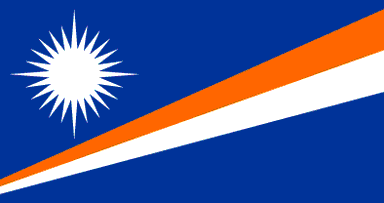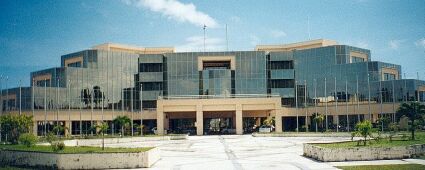
Majuro Atoll,
Republic of the Marshall Islands.
A Photo Essay
by Jon G. O'Neill
 |
Majuro Atoll, Republic of the Marshall Islands. A Photo Essay by Jon G. O'Neill |
|
Majuro Atoll (Mãjro) continued as the administrative and political centre of the Republic of the Marshall Islands after gaining self-government. The 64 islands of Majuro atoll have a combined area of 9.7 square kilometres of land, while the lagoon has a surface area of 295 square kilometres. Out of the total RMI population (est. 2001) of 71,000, almost 20,000 live on Majuro alone. The resultant population density of more than 2,000 people per square kilometre places significant stresses on social and physical infrastructures. The following photographs were taken by the author in 1999 while conducting research in the Marshall Islands for a Post-graduate Honours degree from Charles Sturt University, Australia. |

The House of Parliament for the Republic of the Marshall Islands. Viewed from the south.
|
Bibliographic citation for this documentO'Neill, Jon G. (2002). Majuro Atoll, Republic of the Marshall Islands-- A Photo Essay. URL: http:/marshall.csu.edu.au/Marshalls/html/ONeill/Majuro.htmlCONTACT: Jon G. O'Neill Institute of Land, Water and Society, Charles Sturt University, P.O.Box 789, Albury NSW 2640, Australia. e-mail: jooneill@csu.edu.au OR: Acknowledgement Authorisation to conduct research in the RMI was obtained from the Honorable Mr. Hiroshi Yamamura, Minister of Internal Affairs and Chairman of the Advisory Council on Historic Preservation. Yokwe and komol tata. |
| select from the following... | ||||||
| |
||||||
|
Digital Micronesia-An
Electronic
Library & Archive
is provided free of charge
as an advertising-free
information service
for the world community. It is being maintained by Dirk
HR Spennemann, Associate
Professor in Cultural
Heritage Management, Institute of Land, Water and Society and School
of Environmental & Information Sciences, Charles
Sturt University,
Albury, Australia. The server
space and technical support are provided by Charles
Sturt University as part of its commitment
to regional engagement. Environmental
SciencesInformation
Sciences
|
||||||